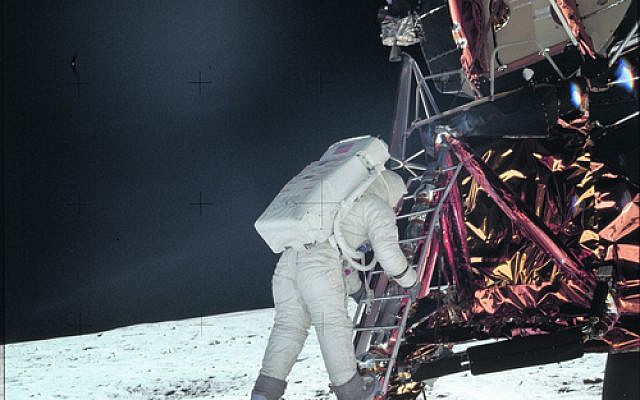The week we went over the moon
'IS it really a half century since humankind first slipped the surly bonds of Earth and trod an extraterrestrial body? Hard to believe'.

IS it really a half century since humankind first slipped the surly bonds of Earth and trod an extraterrestrial body? Hard to believe.
This week’s anniversary of the first moon walk evokes memories of a time when we not only pondered if there’d ever been life on the moon, we doubted there was life in dear old Australia – at least after 6pm.
But by 1969 there was a buzz – sleek cars and bikinis – but on a more serious note, a stirring for change. The 1967 referendum included Indigenous Australians in the Census, the White Australia Policy was fraying, while the Vietnam War drew angry demonstrators into our streets. We had the Don’s Party election – the Saturday that almost overturned two decades of Coalition government, as portrayed in that iconic Bruce Beresford film. But Labor would wait another four years to turn that tide. And as Jews, we were still electrified by the Six-Day War.
Then came July 1969. For eight years, the world had been enthralled by JFK’s call to land an astronaut on the moon by decade’s end, and as a youngster, I followed the Gemini missions, then the Apollo missions, of which Apollo 11 would be the climax.
On July 16, the excitement really began. I was allowed to stay up until midnight and watch TV, a rarity! My family and I sat intently as 11.32pm ticked around – the minute ingrained in my memory – and Apollo 11’s Saturn rocket ascended from its Florida launchpad in smoke and orange flame (we imagined the orange, as the TV was black-and-white). The commentator’s countdown, “11, 10, nine … ignition sequence starts … liftoff, we have a liftoff” still chills me.
It ushered in a breathless week, as astronauts Neil Armstrong, Edwin “Buzz” Aldrin and Michael Collins broke out of Earth’s orbit, made their 384,000 kilometre journey to the moon, and entered lunar orbit. Regular TV programming was shelved, as the channels took live feeds – and Australia proudly became a link to the world, with our dishes at Parkes and Honeysuckle Creek near Canberra.
Suddenly, everyone was a rocket scientist. At school, we mimicked the astro-speak, uttering phrases like, “Roger, Houston, we copy.” As the trio coasted moonwards, talking heads began popping up on the TV. One was University of Melbourne physics professor, Tony Klein, who had written about space travel for The Age. He was scouted by the ABC, rushed to its Melbourne studios, placed under glaring lights and told to start talking into the TV cameras. “I was dazed, but they had press kits and they saved the situation,” the Jewish grandfather recalls. “I had a background in engineering, so that’s what gave me my 15 minutes of fame in the space business.”
Then came July 21. The lunar module Eagle landed on the moon as Australia was waking. At our high school, the enthusiasm reached fever pitch. I was fortunate to be among those kids who had someone at home and were allowed to go home to watch the moon walk. But those pupils whose families were out, it seemed, would miss out. Until Ruth Parasol, a young Jewish teacher, intervened. We’re friends now, and as I would find out years later, she raised hell with the generally apathetic teaching staff, by demanding the school’s TV be rolled into the auditorium so all students could feel part of history.
It was strange to be home at noon on a school day. My mother and grandmother plied me with lunch (you can’t be hungry while witnessing history being made, not in a Jewish home). Then they joined me at the TV. I slung the mike of my audio tape recorder over the channel knob to capture the commentary.
Armstrong pulled a lever activating a camera on Eagle, and 600 million viewers sat transfixed. Cutting a spectral image, he stood on Eagle’s ladder seemingly forever. But at 12.56pm, he lifted his left boot off the craft’s footpad, planted it into the powdery surface, and famously declared, “That’s one small step for a man, one giant leap for mankind.” The three of us would never forget that moment. Nineteen minutes later, Aldrin stepped onto the lunar surface. Armstrong collected soil samples and he and Aldrin planted an American flag.
When Israel flew a drone to the moon this year, sadly it crashed near the surface. Eagle’s descent had also been perilous, we would learn later, and the rousing Earth-to-moon conversation US president Richard Nixon had with the astronauts might readily have been switched for his prepared eulogy. But Armstrong and Aldrin survived to rejoin Collins in the mothership and splash down in the Pacific four days later.
This July, I’m watching the anniversary docos, and The Dish movie. And I’m thinking about “Mrs Parasol”, who gave an auditorium full of curious teens their opportunity to see Armstrong and Aldrin make history on the moon.
Peter Kohn is senior journalist at The AJN.

comments